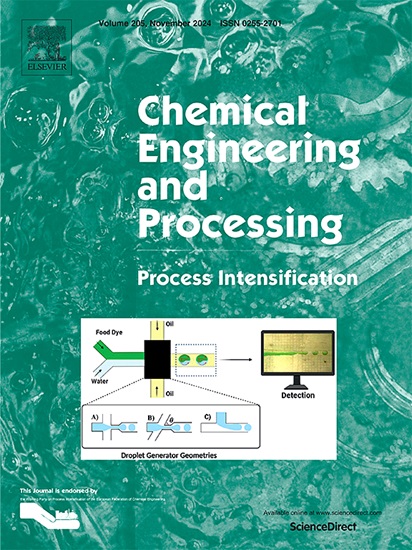循环流化床锅炉循环密封喘振气固流动特性研究
IF 3.8
3区 工程技术
Q3 ENERGY & FUELS
Chemical Engineering and Processing - Process Intensification
Pub Date : 2025-04-15
DOI:10.1016/j.cep.2025.110322
引用次数: 0
摘要
350mwe超临界循环流化床(CFB)锅炉在运行过程中,回路密封的低频喘振会导致内部保温层浇注材料出现裂纹,从而影响锅炉的正常安全运行。采用计算粒子流体力学(CPFD)方法,研究了低频环封喘振对350mwe超临界循环流化床锅炉气固流动的影响。分析了回路密封喘振产生的原因、参数和消除条件。结果表明:当回路密封处于喘振状态时,压降梯度大于临界材料密封值3526 Pa/m,下水管内物料流动不顺畅;物料颗粒在环形密封中的体积分数低,不能有效密封物料。当一次流化风、送风、回风控制在合理范围内时,可有效防止回路密封喘振。一次流化空气的可接受范围为14.5 m/s至16.0 m/s;送风为0.05 m/s ~ 0.10 m/s;循环空气为1.0 m/s ~ 1.5 m/s。本文章由计算机程序翻译,如有差异,请以英文原文为准。

Study on gas-solid flow characteristics of loop seal surge in circulating fluidized bed boiler
During the operation of a 350 MWe supercritical circulating fluidized bed (CFB) boiler, a low-frequency surge in the loop seal can lead to cracks in the castable material of the internal insulation layer, thereby impacting normal and safe boiler operation. Using the computational particle fluid dynamics (CPFD) method, the effect of a low-frequency loop seal surge on the gas-solid flow of a 350 MWe supercritical CFB boiler was studied in this paper. The causes, parameters and elimination conditions of the loop seal surge were analysed. The results show that when the loop seal is under a surge condition, the pressure drop gradient is greater than the critical material sealing value of 3526 Pa/m, and the material flow in the downcomer is not smooth. The volume fraction of material particles in the loop seal is low, which cannot effectively seal the material. When the primary fluidized air, supply air, and recycle air are controlled within a reasonable range, the loop seal surge can be effectively prevented. The acceptable range for primary fluidized air is 14.5 m/s to 16.0 m/s; for supply air, it is 0.05 m/s to 0.10 m/s; and for recycle air, it is 1.0 m/s to 1.5 m/s.
求助全文
通过发布文献求助,成功后即可免费获取论文全文。
去求助
来源期刊
CiteScore
7.80
自引率
9.30%
发文量
408
审稿时长
49 days
期刊介绍:
Chemical Engineering and Processing: Process Intensification is intended for practicing researchers in industry and academia, working in the field of Process Engineering and related to the subject of Process Intensification.Articles published in the Journal demonstrate how novel discoveries, developments and theories in the field of Process Engineering and in particular Process Intensification may be used for analysis and design of innovative equipment and processing methods with substantially improved sustainability, efficiency and environmental performance.

 求助内容:
求助内容: 应助结果提醒方式:
应助结果提醒方式:


